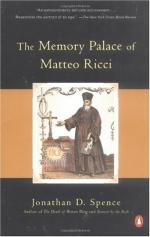
|
| Name: _________________________ | Period: ___________________ |
This quiz consists of 5 multiple choice and 5 short answer questions through Chapter Four, The Second Image: The Huihui.
Multiple Choice Questions
1. How did Ricci change the meaning of the ideograph "yao"?
(a) He used it to represent female Christian converts.
(b) He used to represent the unification of the three Chinese religions.
(c) He used it represent the people of one true God.
(d) He used it to represent Chinese who resisted conversion.
2. According to the charismatic Jesuit missionary, whose mixture of "cruelty, dignity, depravity, and hypocrisy" would prevent them from truly living the faith?
(a) The Japanese.
(b) The Chinese.
(c) The Indians.
(d) The Africans.
3. What did Ricci realize about his attempt at ecumenism when he was a missionary in China?
(a) He realized this was very successful and began to encourage other Jesuit missionaries to dress like the locals.
(b) He realized that women and children were not accepted in Chinese society.
(c) He realized this was not the way to high stature so he began to focus on perceptions of his social status.
(d) He realized that the tenets of the Chinese religions did not align with Christian tenets.
4. According to "Chapter Three, the First Picture: The Apostle in the Waves", to whom did Ricci give the first picture?
(a) Cheng Dayue.
(b) Kwok Sing.
(c) Kim Suk.
(d) Dayue Cheng.
5. How did Ricci use the first four memory images in his memory palace?
(a) To impress his superiors with his knowledge of theology.
(b) To illustrate his strong ability with mnemonic devices.
(c) To help the Chinese understand the life of Christ.
(d) To compare the life of Christ with Confucius.
Short Answer Questions
1. Who endangered marine trips during the 16th century in the Chinese seas?
2. From whom was Macerata in constant danger from attack?
3. What was the new image of the idiograph of "wu"?
4. According to "Chapter One: Building the Palace", how did Ricci believe that humans could remember anything?
5. How long had the Alaleona and Pellicani families been fighting when Ricci was a child in Macerata?
|
This section contains 463 words (approx. 2 pages at 300 words per page) |

|




